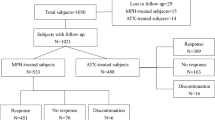Abstract
Objective;To identify ADHD children, to show the prevalence of the disorder in the age group of 5–12 years and to study their socio-demographic variables, associated medical and co-morbid psychological problems.Methods : This is a cross-sectional case study of ADHD children presenting to a child guidance clinic in a busy pediatric hospital over a one year period. The diagnosis of ADHD was based on DSM IV criteria.Results : Of the 238 children referred, 37 were diagnosed as ADHD. 64.9% of the referrals were from pediatricians. The prevalence of ADHD in pediatric clinic was 15.5%, the inattention subtype was predominant. The mean age of boys and girls with ADHD was 8.49 years and 6.82 years respectively. The male to female ratio was 6.4:1. Majority of patients were from middle socio-economic status belonging to Hindu families. 27.0% of children had developmental problems. Oppositional defiant disorder was the most prevalent while depression was the least prevalent co morbid problem.Conclusion : ADHD is prevalent in India and the bunch of these children are mostly presenting to the pediatrician. They need to be aware of the profile of this disorder for early detection and intervention.
Similar content being viewed by others
References
American Psychiatric Association.Diagnostic and Statistical Manual of Mental Disorders. 4th edn. Washington DC: American Psychiatric Association; 1994.
Mahajan BK, Gupta MC. Kuppuswamy scale. InTextbook of Preventive and Social Medicine. India; Jaypee, 1995; 11:134–135.
Sadock BJ, Sadock VA. Hamilton Anxiety Scale and Becks Depression Inventory.Kaplan and Sadock’s Comprehensive Textbook of Psychiatry. USA; Lippincott Williams & Wilkins, 2000; 1(7): 769–771
Connors CK. Rating scales for use in drug studies with children.Psychopharmacol Bull 1973; 9: 24–84.
Freeman FS. Suggested Classification of IQs: Stanford Binet Scale 1916.Theory and Practice of Psychological Testing. UK; Oxford and IBH, 1965; 9: 207.
Bhatia MS, Choudhary S, Sidana A. Attention Deficit Hyperactivity Disorder among Psychiatric Outpatients.Indian Pediatr 1999; 36: 583–587.
Malhi P. Singhi P. Spectrum of Attention Deficit Hyperactivity Disorders in Children among referrals to psychology services.Indian Pediatr 2000; 37:1256–1260.
Gada M. A study of prevalence and pattern of attention deficit disorder with hyperactivity in primary school children.Indian J Psychiatry 1987; 29:113–118.
Chawla PL, Shashi G, Sunderam KR, Mehta M. A study of prevalence pattern of hyperactive syndrome in primary school children.Indian J Psychiatry 1981; 23: 313–323.
Sidana A, Bhatia MS, Choudhary S. Prevalence and pattern of psychiatric morbidity in children.Indian J Med Science 1998; 52(12): 556–558.
Costello EJ, Costello AJ, Edelbrock C. Psychiatric disorders in pediatric primary care.Arch Gen Psychiatry 1988; 45:1107–1116
Lindgren S, Wolraich M, Stromquist Aet al. Diagnosis of attention-deficit/hyperactivity disorder by primary care physicians. Paper presented at the Mental Health Services for Children and Adolescents in Primary Care Settings: A Research Conference; 1989; New Haven, CT.
Biederman J, Milberger S, Faraone SV, Kiely K, Guite J, Mick Eet al. Family-environment risk factors for attention-deficit hyperactivity disorder. A test of Rutter’s indicators of adversity.Arch Gen Psychiatry 1995; 52(6): 464–470.
Botting N, Powls A, Cooke RW, Marlow N. Attention deficit hyperactivity disorders and other psychiatric outcomes in very low birth weight children at 12 years.J Child Psychol Psychiatry 1997; 38(8): 931.
Breslau N, Brown GG, DelDotto JEet al. Psychiatric sequelae of low birth weight at 6 years of age.J Abnorm Child Psychol 1996; 24(3): 385–400.
Robson WL, Jackson HP, Blackhurst D, Leung AK. Enuresis in children with attention-deficit hyperactivity disorder.South Med J 1997; 90(5): 503–505.
Green M, Wong M, Atkins D, Taylor J, Feinlieb M. Diagnosis of Attention-Deficit/Hyperactivity Disorder. (Technical Review #3). Rockville, MD: Agency for Health Care Policy and Research; 1999.
Marshall RM, Hynd GW, Handwerk MJ, Hall J. Academic underachievement in ADHD subtypes.J Learn Disabil 1999; 30(6): 635–642.
Author information
Authors and Affiliations
Corresponding author
Rights and permissions
About this article
Cite this article
Mukhopadhyay, M., Misra(Chatterjee), S., Mitra, T. et al. Attention deficit hyperactivity disorder. Indian J Pediatr 70, 789–792 (2003). https://doi.org/10.1007/BF02723796
Issue Date:
DOI: https://doi.org/10.1007/BF02723796




